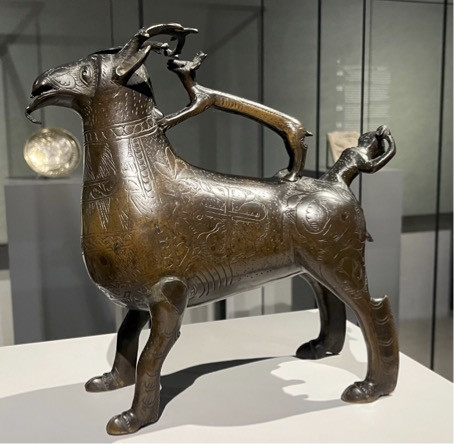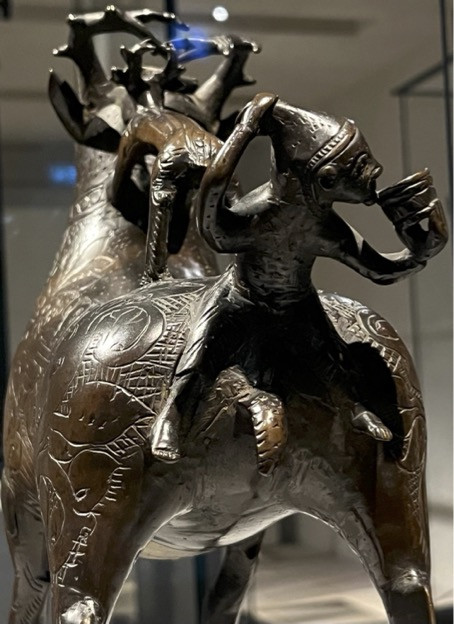
Katharina Heyden, 2023
An Islamic-Christian Water Can and the Question of the Third in Religious Co-production

Karlsruhe, Badisches Landesmuseum Inv. no. 65/101; copper casting, unknown artist, Hildesheim, early 13th century, height 27.5 cm, length 29 cm, shown in the exhibition “Islam in Europa”, 1000-1250 in the Dommuseum Hildesheim, 7.9.22-12.2.22 (photo: Katharina Heyden).
The figure of the "third" often emerges in the co-productive dynamics between Judaism, Christianity and Islam. That is, where two of the sibling religions, we often find the third imagined as well. A deer-shaped medieval water can provides an exquisite example of the phenomenon.
"As the deer pants for water brooks, so pants my soul for You, God,” runs a verse from the Hebrew Bible’s Psalm 42. In his influential encyclopedia of animals, the 9th-century Muslim scholar Al-Ǧāḥiz drew on an adaptation of this verse to comment on the hesitant drinking behavior of deer: "The Prophet David says in the Psalms, ‘My longing for the Messiah is like that of a deer when he eats snakes.’ For when it does, it is overcome by a great thirst. It is seen walking around the water but is kept from drinking by its knowledge that this would be its downfall. For the poison would flow into the water and get into orifices of the body not intended for ingestion." (Kitāb al-Ḥayawān VII, 29-30). Perhaps he was inspired as well by the most influential bestiary of the late antique world, the Physiologus (ch. 30), a collection of allegorizing Christian nature lore that became widely known in many medieval societies and languages.
Such reflections about spiritual thirst and drink probably also inspired the figurative design of water cans, so-called aquamaniles, which have been used in Muslim cultures to wash hands since the 7th century. From the 12th century onwards, similar handheld copper vessels were also produced in Europe, a corollary of the increasing contacts between cultures, which intensified during this period, not least due to the Crusades. A particularly remarkable aquamanile crafted in the shape of a deer was produced in the first decades of the 13th century, presumably in the episcopal city of Hildesheim, located in the northern present-day Germany.
While there is a comparative example from Fatimid Egypt, also in the shape of a deer with a smaller animal as a handle on its back (see the image at the end of this article), the design of the Hildesheim aquamanile is much more elaborate. Its decorations are reminiscent of the floral ornamentation of Fatimid art, but the leafy tendrils of the Hildesheim piece form a cross on both sides of the deer. The lavishly designed antlers of the smaller and larger deer may have been inspired by the church father Augustine, who in his interpretation of the aforementioned verse points out that deer help each other cross waters by interlocking their antlers.
The most remarkable detail of the Hildesheim aquamanile is the human figure sitting on the rump of the deer. The man is carrying a round vessel in his left hand and grasping a hat with his right. What are we to make of this figure? To Northern Europeans of the time, the pointed hat would have clearly identified the man as a stranger from the Orient. Is this stranger meant to remind Western Christians that people in the Orient also pant for God like the deer? Perhaps.
But the figure could also represent a Jew, which would put an anti-Jewish punchline on the entire vessel. The pointed hat had prevailed as a negatively connoted attribute for Jews in European Christian art since the late 12th century. Furthermore, the position of the figure on the deer’s butt is reminiscent of sculptural representations of the so-called ‘Jews sows’, which were featured on European cathedrals of the time. And we also must not forget that the Hildesheim aquamanile was produced in the decades when the first allegations of water poisoning by Jews began to surface in Christian societies.
The relative plausibility of these two interpretations depends not least upon the physical perspective one takes to view the aquamanile. Looking at the standing deer from the side, the figure on its backside appears to be drinking. When looking the figure in the face, however, one cannot avoid simultaneously staring at the butts of the two deer, and also, immediately noticing that the man does not actually bring the vessel to his mouth. Were we to use the aquamanile according to its original purpose, for pouring water, then one can imagine that the contents of the small vessel (which itself recalls the shape of a well) in the left hand of the stranger would automatically pour into the water that flows from the mouth of the deer. Remember how Al-Ǧāḥiz explained the deer’s hesitation to drink: “For the poison would flow into the water and get into orifices of the body not intended for ingestion."

Detail Aquamanile (fig. 1)
When Christians imitated deer-shaped Islamic water cans intended to cleanse hands, were they putting an unclean Jew on the rump of the deer? This question cannot be answered unambiguously. Precisely because of this ambiguity, the aquamanile of Hildesheim represents an ambivalent dynamic inherent in almost every instance of co-production of the three religious cultures of Islam, Judaism and Christianity. A dynamic that involves rapprochement or appropriation between two of the three religions all too often produces, or at the very least enables, the co-production of the "unlucky third".

Fatimid aquamanile, Napoli, Museo e Gallerie Nazionale di Capodimonte, Inv.: N.A.M. 138798, Fatimid Egypt, height 38 cm, length 27,3 cm, copper, (photo: Katharina Heyden)
Further Reading
Islam in Europa. 1000-1250, ed. by Claudia Höhl, Felix Prinz, and Pavla Ralcheva, Stuttgart. Schnell & Steiner 2022.
Lubrich, Naomi, The Wandering Hat: Iterations of the Medieval Jewish Pointed Cap, in: Jewish History 29 (2015), 203-244.
Olchawa, Joanna, Aquamanilen. Genese, Verbreitung und Bedeutung in islamischen und christlichen Zeremonien (Bronzegeräte des Mittelalters 1), Regensburg 2019.